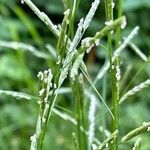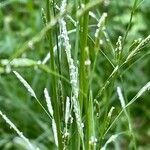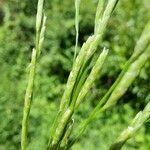Perennial, forming loose patches. Culms spongy, ascending from prostrate base, rooting at lower nodes, 30–100 cm tall, 3–6 mm in diam. Leaf sheaths keeled, scabrid in upper part, longer than internodes; leaf blades flat or folded, flaccid, green or gray-green, 6–30 cm × 4–10 mm, abaxial surface smooth or scabrid, adaxial surface scabrid, apex acute; ligule 3–6 mm. Panicle lanceolate at first, ovate at maturity, up to 30 cm; branches 3–5 at lower nodes, finally widely spreading, longer branches bearing up to 15 spikelets. Spikelets linear-oblong, cylindrical or slightly laterally compressed, 1–2.5 cm, florets 5–16, grayish green or purplish; glumes ovate, membranous, 1-veined, lower glume 1.4–2.3 mm, upper glume 2.5–4 mm, apex rounded; lemmas broadly elliptic or obovate-oblong, 3.5–4.5 mm, firmly herbaceous, scabrid, 7-veined, apex membranous, broadly obtuse; palea as long as lemma, keels narrowly winged, apex 2-denticulate. Stamens 3, anthers 0.8–1.4 mm. Fl. Jun–Aug. 2n = 40.
More
Rhizomatous perennial, often rooting and branching at lower nodes. Culms ascending, to 100 cm high. Leaves: sheaths cross-veined (often apparent only on adaxial surface); ligule 2–8.5 mm long, obtuse to acute, becoming lacerated; blade 5–30 cm long, 3–14 mm wide, very weakly cross-veined, adaxially scaberulous or scabrous. Inflorescences slender panicles or sometimes reduced to racemes, often interrupted, 10–50 cm long. Spikelets narrowly oblong, 15–25 mm long, with 7–16 bisexual florets; rachilla glabrous. Glumes oblong to ovate, acute to narrowly obtuse, 1-nerved; lower glume 1.5–2.6 mm long; upper glume 2.6–4 mm long. Lemma oblong, 3.5–5.1 mm long, obtuse, entire or weakly irregularly indented, dorsally rounded, with nerves often falling short of apex, scaberulous. Palea slightly shorter than or equal to lemma, minutely bidentate, glabrous. Anthers 1.2–1.5 mm long. Caryopsis dorsiventrally compressed, not grooved.




